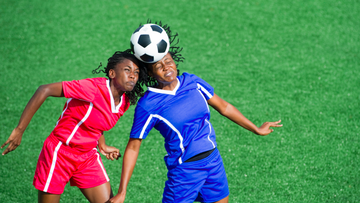Introduction
Storelli presents "Concussions in Soccer " a series focused on the recognition, recovery and return phases in managing a concussion. As head injuries, head protection and header protocols have never been hotter topics in the world of soccer, our medical advisor Dr. Raymond Rocco Monto offers a number of head injury facts and best practices to help us make the Beautiful Game as safe as we can.
Part 1 addresses Recognition followed by Part 2 which focuses on both Recovery and Return. This should help you feel better prepared as a parent, coach and player for recognizing concussions with time to take the right course of action.
Recognition: What is a concussion?
A concussion is a traumatic brain injury that results from a blow to the head or body that results in a violent shift of the brain. Because the brain floats in a pool of cerebrospinal fluid, a shearing force can cause it to bounce off the skull, injuring neurons. New research shows that concussive injury to the brain leads to nerve damage and inflammation that can last up to one year. Luckily, most injuries will heal, but the long-term effects of repetitive concussions remain uncertain. Despite extensive media attention in American football, there is no definitive link between soccer head injuries and the degenerative brain disease, chronic traumatic encephalopathy (CTE).

Source: Comstock RD, Currie DW, Pierpoint LA, Grubenhoff JA, Fields SK: An evidence-based discussion of heading the ball and concussions in high school soccer. JAMA Pediatrics. 2015 Sep;169(9):830-7.
There are at least 330,000 sport concussions every year in the US alone with more than 50,000 occurring in high school athletes. Women have a 2-3 X higher risk of concussion. The reason for this gender bias are unclear but may be the result of hormone level or neck strength differences. Another reason is that the brain’s white matter is more vulnerable to concussive injury and women have more white matter than men. In soccer, over 80% of concussions in men and 60% in women come from head-to-head collisions, not heading.

Source: American Academy of Neurology Concussion Guidelines
Youth soccer players have a higher risk of concussive injuries because their brains are still developing. Soccer goalkeepers have a 50% higher risk of concussion than field players.
Recognition: How Do I Know I Have a Concussion?
Concussions often go unreported because 90% do not result in a loss of consciousness and players, coaches, and family members are not aware of the many different expressions of brain injury.

Source: Maher ME, Hutchison M, Cusimano M, Comper P, Schweizer TA: Concussions and heading in soccer: a review of the evidence of incidence, mechanisms, biomarkers and neurocognitive outcomes. 2014;28(3):271-85
A recent FIFA study found that athletes have a 50% higher body injury rate in the year following a concussion. Repeat concussions are common and re-injury of the brain before it has recovered can lead to a dangerous and potentially lethal condition called second-impact syndrome. This short-circuits your brain’s blood flow regulatory system, literally choking off the oxygen to your precious nugget. It is one of the leading causes of death in adolescent male athletes.

Source: Nordstrom A, Nordstrom P, Ekstrand J: Sports-related concussion increases the risk of subsequent injury by about 50% in elite male football players. British Journal of Sport Medicine. 2014;1447-1450.
The message here is, if you’ve had a hard shot to the head and you have any of these symptoms (or “don’t feel quite right”), get yourself to a doctor and get checked out for a possible concussion. Recognition is the first and most crucial step in the concussion healing. Stay tuned for Part 2: Recovery and Return (coming soon)
Dr. Raymond Rocco Monto is a contributing writer for Storelli.com focused on soccer training techniques and mental and physical exercises to help better your game.

